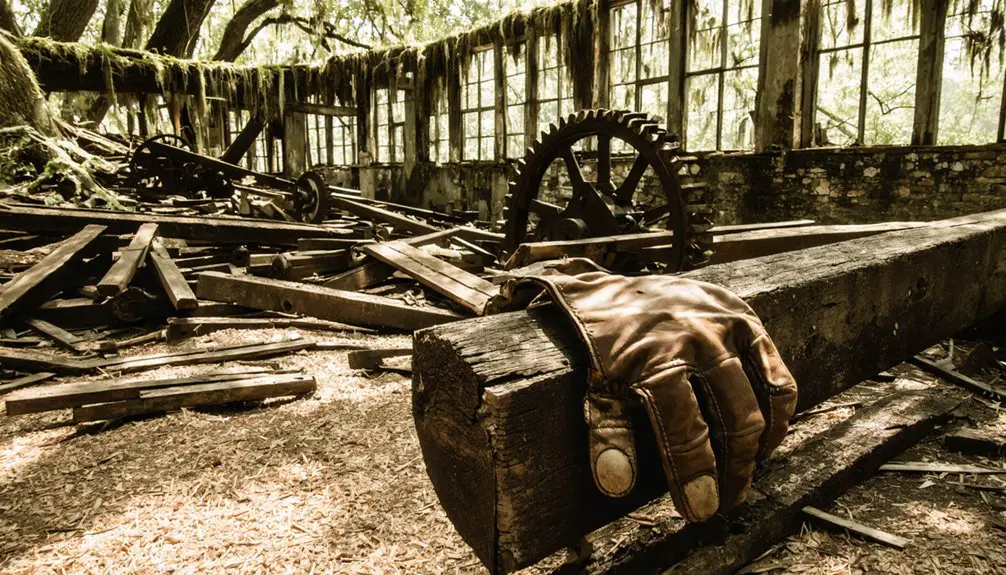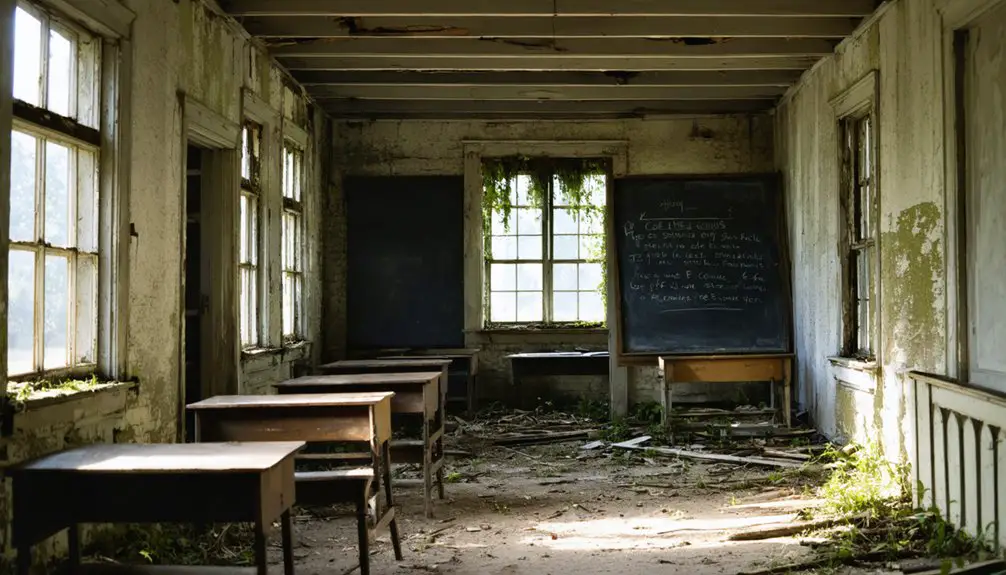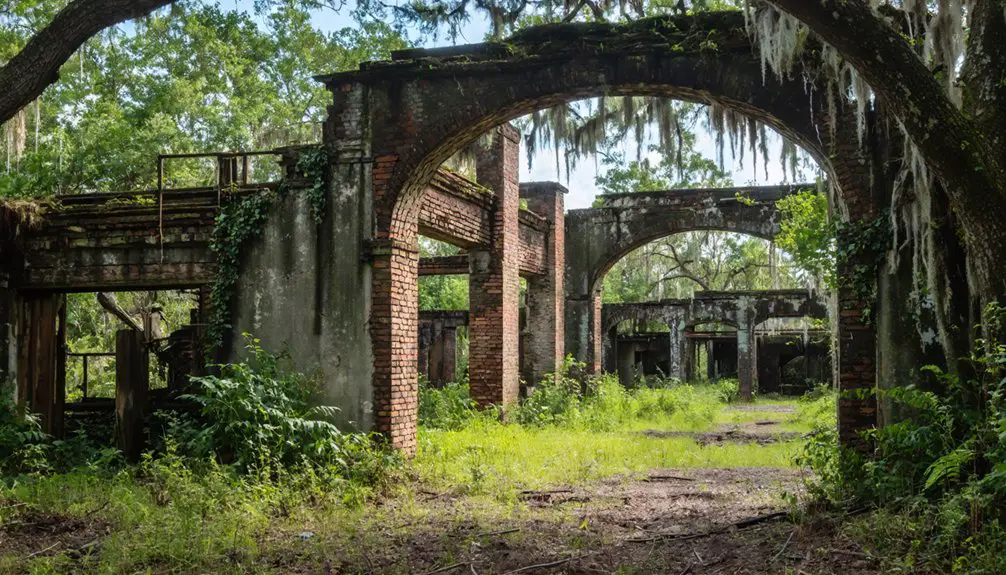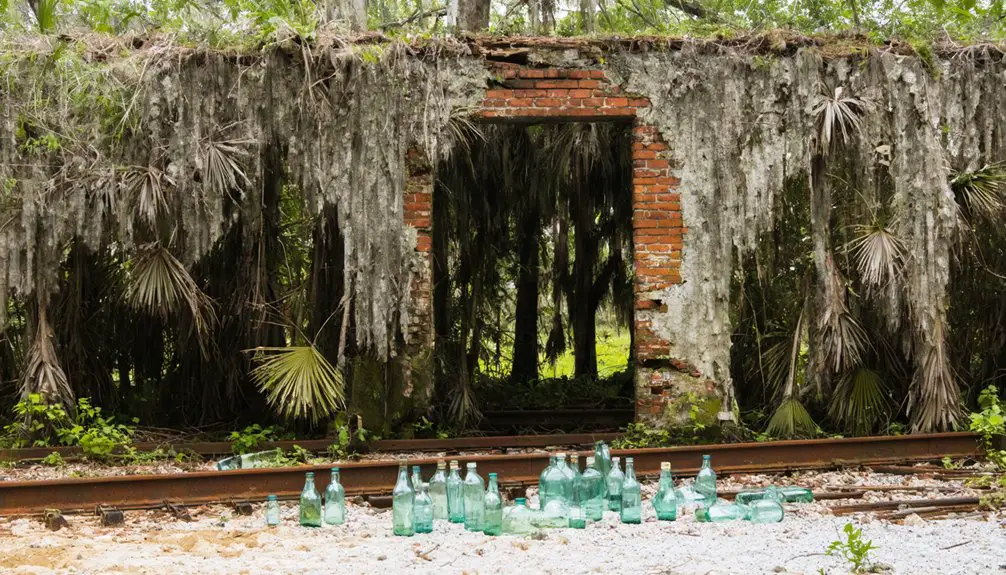You’ll find the ghost town of Fivay in Florida’s timber country, where five Georgia investors built the state’s largest sawmill operation in the early 1900s. At its peak in 1910, the bustling company town housed 2,300 residents, featuring electric lights, plank streets, and modern amenities. Workers processed 250,000 board feet of lumber daily until 1912, when depleted timber resources forced the Aripeka Saw Mill to close. The abandoned town’s rich history holds surprising tales of innovation, inequality, and industrial ambition.
Key Takeaways
- Fivay was once Florida’s largest sawmill town, established by five Georgia investors and producing 250,000 board feet daily by 1910.
- The town featured modern amenities including electric lights, running water, and plank streets for its 2,300 residents.
- Aripeka Saw Mill Company’s closure in 1912 due to depleted timber resources led to Fivay’s abandonment.
- The company town’s infrastructure included worker housing, social facilities, and a mill complex powered by 14 locomotives.
- After the mill’s closure and equipment liquidation, Fivay transformed from a bustling lumber town into an abandoned ghost town.
The Birth of a Lumber Empire
While the Florida timber industry was booming in the early 1900s, five ambitious Georgia investors saw an opportunity to establish what would become one of the state’s largest lumber operations.
These entrepreneurs – Abbott, Amorous, Arkwright, Atkinson, and Ayer – leveraged their experience from Atlanta’s railway and electric industries to create a venture they’d name “Fivay” after their shared initial.
Five visionary Atlanta businessmen, united by their ‘A’ surnames, forged a pioneering lumber empire aptly named Fivay.
You’ll find their lumber techniques were ahead of their time. They didn’t just reopen a defunct sawmill; they built a massive brick facility with advanced milling capabilities and connected it to essential transport networks through the Tampa Northern Railroad. The local workforce needs prompted the development of schools and other community services.
The economic impact was immediate and far-reaching. By 1910, their operation could process 250,000 board feet daily, employing 1,500 workers and transforming a quiet stretch of Florida wilderness into a bustling industrial powerhouse. The company operated fourteen locomotives and maintained 75 miles of tram road to transport lumber efficiently throughout the region.
Rise to Industrial Prominence
The ambitious vision of Fivay’s founders quickly transformed into tangible industrial might. You’d find yourself in Florida’s largest sawmill operation by 1910, where industrial innovation drove production to an impressive 250,000 board feet of lumber daily.
Steam-powered machinery hummed continuously while a diverse workforce of up to 1,500 laborers kept the operation running. Unskilled black laborers earned $1.50 per day working the sawmills.
The economic impact rippled through the region as the company built the Tampa Northern Railroad, connecting Fivay to broader markets.
You’d witness a bustling industrial center with 75 miles of tram roads, a brick mill building, and extensive railroad shops employing 50 skilled workers.
The three hotels and clubhouse provided comfortable accommodations for workers and visitors alike.
The town’s infrastructure featured modern amenities like electric lights and running water, supported by a towering 100,000-gallon water tank that served a population reaching 2,300 residents.
Daily Life in the Company Town
If you’d have lived in Fivay during its heyday, you’d have found yourself in a modern company town complete with electric lights, running water, and plank streets connecting around 100 worker residences.
You’d have spent your workdays at either the bustling sawmill or railroad shops alongside roughly 50 other employees, operating fourteen locomotives and handling timber as part of Florida’s largest sawmill operation.
Workers who got too rowdy on weekends faced time in the town’s detention system, where a judge would issue random fines using a Sears catalog to ensure fairness.
After hours, you could’ve enjoyed the town’s social amenities, including tennis courts, golf links, and weekend gatherings at the clubhouse that drew visitors from as far as Jacksonville.
Work and Living Conditions
During Fivay’s peak years around 1910, workers flocked to Florida’s largest sawmill operation, where daily wages ranged from $1.50 for unskilled laborers to $2.50 and above for skilled positions.
You’d find yourself among 2,300 residents, mostly living in company-built houses equipped with modern conveniences like electric lights and running water.
While worker safety remained a concern with the intense daily shifts processing 250,000 board feet of timber, the 100,000-gallon water tank provided essential fire protection.
Under strict community governance, you’d still enjoy amenities rare for the era. The town’s name originated from five men who invested in the lumber operation.
The company provided a commissary for supplies, recreational facilities including tennis courts and golf links, and planked streets for easy movement.
The railroad shops and sawmill employed around 50 specialized workers, while others operated steam skidders and hauled logs via mule carts.
Social Activities After Hours
While laboring through long shifts at the sawmill, Fivay’s residents could look forward to vibrant social activities centered around the town’s well-appointed clubhouse.
You’d find your neighbors enjoying tennis matches or rounds of golf, activities that were rare luxuries in company towns of that era. As evening fell, electric lights illuminated gathering spots where you could socialize at the soda fountain or participate in community events.
Weekend affairs drew visitors from Jacksonville via the Tampa & Northern railway, expanding your social circle beyond the town’s boundaries. The three hotels buzzed with out-of-town guests, while the park provided a peaceful setting for outdoor relaxation.
Social bonding flourished through dances, card games, and evening gatherings that united workers and their families.
Community Support Systems
Living in Fivay meant you’d benefit from an extensive network of company-provided amenities that defined daily life in this bustling lumber town. You’d find strong community support networks through the centrally-located commissary, where you could purchase daily necessities, and a drugstore that served both medical needs and social gatherings at its soda fountain.
The town’s infrastructure showcased modern conveniences you wouldn’t typically find in early 1900s rural Florida. Your home would’ve been one of 100 houses equipped with electric lighting and running water from a 100,000-gallon tank.
For community engagement, you’d have access to a post office until 1912, enabling communication with the outside world. With weekly payrolls reaching $2,000, you’d enjoy stable employment and the security of a self-sustained community.
Working at the Aripeka Saw Mill

If you’d worked at the Aripeka Saw Mill in Fivay around 1910, you’d have earned about $1.50 per day alongside 1,500 to 2,000 other laborers, most of whom were Black men performing physically demanding jobs.
You’d likely have lived in one of the company-built houses in town, though early workers initially commuted by work-train from places like Brooksville before relocating closer to the mill.
Your daily routine would’ve involved operating steam skidders, managing mule-drawn log carts, or working the tram roads that transported timber through the vast logging operation.
The mill’s operations were powered by two electric plants that supplied energy to both the industrial facilities and the town’s homes.
Daily Mill Operations
During its peak operations from 1904 to 1912, the Aripeka Saw Mills employed up to 2,000 workers who faced demanding daily routines processing cypress timber.
You’d find logging efficiency centered around a complex system of steam-powered machinery advancements, with up to 14 locomotives hauling massive logs to the mill site.
Once logs arrived, you’d see them dumped into the mill pond before moving through the steam-powered saws.
The workflow relied on coordinated efforts between skilled operators managing the heavy machinery and laborers handling the timber.
You’d witness an intricate dance of mule teams pulling log carts along tram roads, while steam skidders dragged cypress from swampy terrain.
Despite the impressive scale, the operation wasn’t sustainable – they only harvested the largest trees, leaving significant waste behind.
Worker Housing Conditions
The stark contrast between worker housing at Fivay’s Aripeka Saw Mill revealed deep racial inequities that shaped daily life.
While the town boasted electric lights and waterworks for up to 2,000 people, you’d find Black workers confined to “colored quarters” outside town limits in cramped two-room shanties lacking basic amenities.
If you’d lived there as a Black worker, you’d have shared tight spaces with multiple family members, sleeping on wooden floors and relying on wood-burning stoves for heat and cooking. The segregated mill operations used steam boilers for power while denying basic utilities to Black worker housing.
The segregated housing created severe sanitation issues, with no indoor plumbing or running water.
Meanwhile, white workers enjoyed well-maintained bungalows with electricity and proper facilities.
Sundown curfews and warning signs, likely posted by Klan members, further enforced the strict racial divide in residential areas.
Wages and Work Shifts
Life at Aripeka Saw Mill revolved around grueling work shifts that paid about $1.50 per day for unskilled Black laborers, who made up most of the workforce. The wage disparity between skilled and unskilled workers reflected the labor segregation of the time, with skilled positions commanding higher pay. Workers at similar mills like Cummer and Sons earned 10 cents per hour.
You’d find your earnings partially paid in company coupons, forcing you to shop at the company store.
Here’s what you’d experience working at the mill:
- Eight-hour shifts became standard by the 1940s, though earlier periods likely saw longer hours.
- Your workday followed the demands of steam-powered equipment and log hauling operations.
- If you lived in nearby towns, you’d commute by work train on strict schedules, limiting your freedom of movement.
Social Dynamics and Community Structure

Centered around the bustling Aripeka Saw Mill Company, Fivay’s social structure reflected a typical early 20th-century mill town hierarchy, with five founding investors at the top and laborers at the base.
You’d find clear social stratification between the “Five A’s” investors who controlled operations and the workers who made up most of the 2,300 residents packed into less than a square mile.
Community cohesion developed through shared spaces like the club house and daily interactions at the mill and railroad junction. As the town’s backbone, the sawmill’s schedule dictated social rhythms, while the post office and railroad depot served as key gathering points.
When timber resources depleted around 1912, this tight-knit social fabric began unraveling. By 1919, only 250 residents remained, marking the collapse of Fivay’s organized community structure.
The Final Days of Operations
After operating for eight years as one of Florida’s largest logging ventures, Aripeka Saw Mill Company shut down in 1912 when nearby timber resources could no longer sustain production.
Despite eight years as a major Florida logging operation, Aripeka Saw Mill Company collapsed in 1912 when local timber supplies ran dry.
Economic challenges mounted as specialized equipment like steam-driven skidders and tram road systems couldn’t offset the dwindling timber supply. Under Superintendent William Archer Gower’s direction, the company began liquidating its assets.
Key events during the operational decline included:
- Failed attempts to sell the town and mill equipment in 1911
- Sale of timber rights to Gulf Pine Company and Hart Lumber Co.
- Liquidation of valuable equipment including engines, boilers, band sawmill, and locomotives
You’ll find that while most physical traces have vanished near Fivay Road and Little Road junction, the town’s legacy lives on through historical documentation.
From Bustling Town to Abandonment

While Fivay thrived as Florida’s largest logging operation in 1910 with nearly 2,000 residents, the town’s prosperity proved short-lived.
Despite impressive logging technology, including 14 locomotives, 50 logging cars, and steam-driven skidders, the venture couldn’t sustain itself.
The economic impact of depleting old-growth cypress and timber within just a decade proved devastating.
Modern Traces and Urban Development
Today’s visitors to Fivay’s former site will find only scattered remnants of its once-bustling logging operation.
Urban encroachment has steadily transformed the landscape, with modern roads and residential developments now dominating where timber mills once stood.
You’ll find the most visible traces near Cricket Street, where a historic logging pond and concrete foundations still mark the town’s industrial heritage.
Here’s what you can still discover at Fivay:
- Concrete ramps and sawmill foundations that hint at the scale of lumber operations
- The original logging pond, accessible off Cricket Street near Fivay Road
- Wall remnants of the general store and boarding house, though they’re increasingly threatened by development
Historical preservation faces ongoing challenges as private property ownership and suburban growth continue to reshape this significant piece of Florida’s past.
Preserving Fivay’s Historical Legacy
Despite significant urban development erasing much of Fivay’s physical presence, dedicated local historians and organizations have worked to preserve the ghost town’s legacy through various documentation efforts.
You’ll find detailed records on Fivay.org, showcasing the town’s historical significance through population data, industrial activities, and rare photographs of the sawmill operations that once dominated the landscape.
While the logging pond near Fivay Road remains the only tangible remnant, community engagement continues through online platforms, personal accounts, and archived materials.
Local enthusiasts like Jeff Cannon and Jeff Miller have documented remaining evidence, while descendants of original settlers share oral histories.
Though preservation faces challenges from private land ownership and urban sprawl, these combined efforts guarantee Fivay’s story won’t be forgotten.
Frequently Asked Questions
What Happened to the Original Five ‘A’ Investors After Fivay Closed?
You’ll find the investor fates were straightforward – they liquidated their assets through William Gower’s management, abandoned their Florida lumber interests, and departed after realizing the economic impact of insufficient timber resources.
Were There Any Major Accidents or Deaths at the Sawmill?
Imagine you’re operating a steam skidder in dangerous conditions. While specific sawmill accidents weren’t well documented, records suggest worker fatalities occurred regularly at Fivay due to minimal safety protocols during 1904-1912.
Did Any Original Fivay Buildings Survive Into the 21ST Century?
You won’t find any original buildings standing today – despite their architectural significance, Fivay’s structures weren’t built for historic preservation. Only concrete foundations and the old logging pond remain accessible.
What Native American Tribes Lived in the Area Before Fivay?
After 70 years of prosperity, the Chocochatti Seminoles were your area’s last major tribal presence. They’d inherited the land from earlier Upper Creek settlers, who’d replaced the ancient Timucua and Calusa peoples.
Did Any Former Fivay Residents or Their Descendants Become Locally Prominent?
You’ll find only William Archer Gower achieved local prominence after Fivay’s decline, purchasing 80 acres and managing land sales. Other prominent descendants aren’t documented in local history records.
References
- http://www.gribblenation.org/2018/04/ghost-town-tuesday-fivay-fl.html
- https://www.fivay.org/fivay.html
- https://www.tampabay.com/archive/1996/08/04/in-the-early-1900s-fivay-rose-and-fell-with-its-sawmills/
- https://freepages.history.rootsweb.com/~gtusa/usa/fl.htm
- https://www.youtube.com/watch?v=fAu5kj5Q5uo
- https://westpascomuseum.org/pascohistory/historicalinformation/miscellaneous-info/black-history/
- https://naturecoaster.com/lacoochee-lumber/
- https://www.hmdb.org/m.asp?m=260791
- https://fivayhistory.weebly.com
- https://www.eastpascochamber.org/east-pasco-chamber-of-commerce-history/



